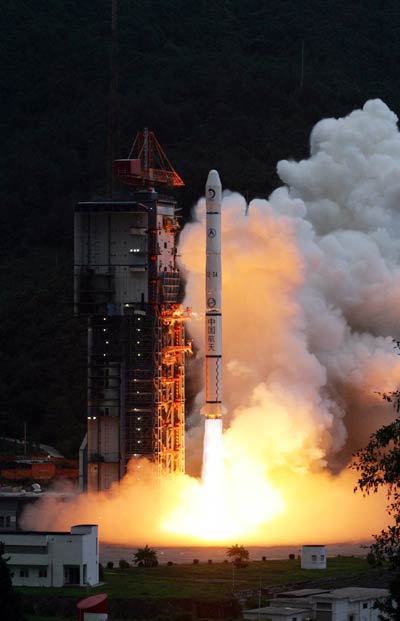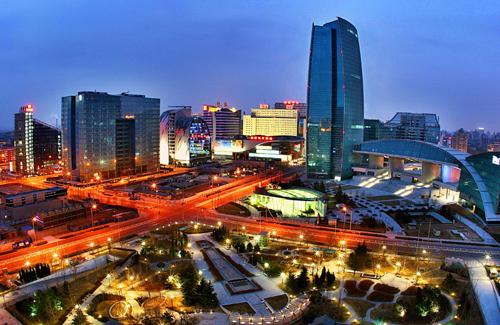Achievements
Development of Science and Technology in New China
(chinadaily.com.cn)
Updated: 2010-12-12 11:42
Modern Development In 1900, China had no modern science and technology at all—fewer than 10 people in all China understood calculus. Now in the early 21st century, the high-technology research and development gap between China and the world’s advanced countries has visibly shrunk; 60 percent of technologies, including atomic energy, space, high-energy physics, biology, computer, information technology and robot, have reached or are close to the world advanced level.
The successful launches of manned spacecraft in 2003 and 2005, as well as the launch of the moon probe satellite, marked a leap in Chinese astronautics. In September 2008, China launched the manned Shenzhou VII, and a Chinese astronaut successfully made China’s first-ever space walk. China became the world’s third country to master the technologies required for space walks. According to China’s moon probe plan, China will launch unmanned probes to the moon before 2010, and gather moon soil samples before 2020.

The amount of expenditures on research and development (R&D) activities was worth 457.0 billion yuan in 2008, up 23.2 percent over 2007, accounting for 1.52 percent of the country’s GDP. Of this total, 20 billion yuan was appropriated for fundamental research programs. A total number of 922 projects under the National Key Technology Research and Development Program and 1,205 projects under the Hi-tech Research and Development Program (the “863 Program”) were implemented.
The year 2008 saw the establishment of seven new national engineering research centers and 51 national engineering laboratories. The number of state validated enterprise technological centers reached 575 by the end of the year. The technology centers at the provincial level numbered 4,886. Some 828,000 patent applications were made both home and abroad, of which 717,000 were domestic ones, accounting for 86.6 percent of the total. A total number of 290,000 patent applications for new inventions were accepted, of which 195,000 were from domestic applicants or 67.1 percent of the total.
By the end of 2008, there were altogether 24,300 laboratories for product inspection, including 376 national inspection centers. There were 170 organizations for product certification and management system certification, which accumulatively certified products in 38,000 enterprises. A total of 3,071 authorized measurement institutions enforced compulsory inspection on 41.90 million measurement instruments in the year. A total of 6,373 national standards were developed or revised in the year, including 2,714 new standards. There were 1,314 seismological monitor stations and 31 seismological remote monitoring network stations. Oceanic observation stations numbered 67 and oceanic monitoring spots reached 9,200. Mapping departments published 1,834 maps and 309 mapping books.
As China’s largest scientific and technology project of the 20th century since the reform and opening-up policies were introduced, the national Key Science and Technology Project was approved at the Fifth Meeting of the Fifth National People’s Congress on November 30, 1982. The project’s goal is to solve long-lasting problems of overall importance related to agriculture, electronic information, energy resources, transportation, materials, resources survey, environment protection, medical care and sanitation, etc., in national economic and social development. So far, it remains largest science and technology undertaking that produces the most widespread influence on the national economy.
The implementation of the Projects has played a significant role in the sustainable development of China’s economy, science and technology, national defense and society. During the 10th Five-Year Plan (2001-2005) period, through the Project 210 important and significant items were arranged in the eight fields of agriculture, information, automation, materials, resources and transportation, resources and environment, medical care and sanitation, and public services. And during the period of the 11th Five-Year Plan (2006-2010), stress is given to the R&D of public service technology, key general technology, and enterprise participation to establish the mechanism of the integrating manufacturing with research; strong support is provided to industries in the fields of energy resources, natural resources, environment, agriculture, medicine and sanitation.
China has developed sci-tech cooperation relations with 152 countries and regions, signing intergovernmental sci-tech cooperation agreements with 96 of them, and joined more than 1,000 international sci-tech cooperation organizations. Non-governmental international sci-tech cooperation and exchanges remain active. The China Association for Science and Technology and its affiliated organizations have joined 249 international scientific and technological organizations, and more than 250 CAS scientists have held posts in international scientific organizations. The China National Science Foundation has conclude cooperative agreements and memoranda with their counterparts in 36 countries.
The Chinese Academy of Sciences, as well as a dozen famous universities and colleges, including Peking University and Tsinghua University, are located in the Zhongguancun area in Beijing’s Haidian District. Boasting a dynamic economy based on knowledge and information industries, Zhongguancun employs hundreds of thousands of professionals averaging about 30 in age. It is thus popularly known as the “Silicon Valley of China.”

Zhongguancun is a product of the implementations of the reform and opening-up policy and the development of market economy in China. Starting in the late 1980s, the Chinese government decided to focus its attention on economic development. On October 23,1980, Chen Chunxian, a researcher at the Chinese Academy of Sciences, established a technological development service shop under the Beijing Society of Plasma Physics in Zhongguancun. It was the first civilian-run scientific and technological business in the area.
The Zhongguancun Scientific and Technological Garden was established in June 1999. It was the first state-level hi-tech industry development zone ever founded in China.
 CPC Heroes
CPC Heroes
Zhu De
Zhu De, born in Yilong County of Sichuan Province in 1886 and passed away in 1976, is a great Marxist, proletarian revolutionary, statesman and military strategist.
Chen Yi
A native of Le Zhi, in Southwest China's Sichuan Province, and awarded by the People's Republic of China the military rank of marshal; Served as the country's Vice Premier (1954-1972) and Foreign Minister (1958-1972)

